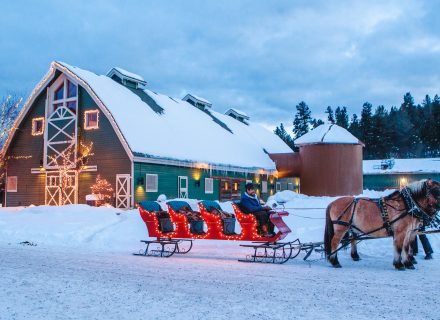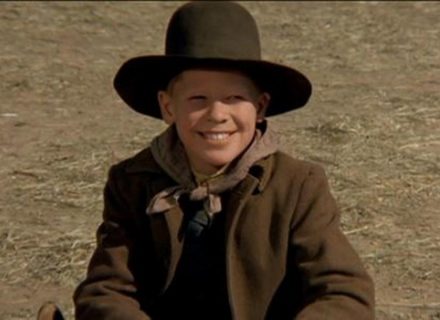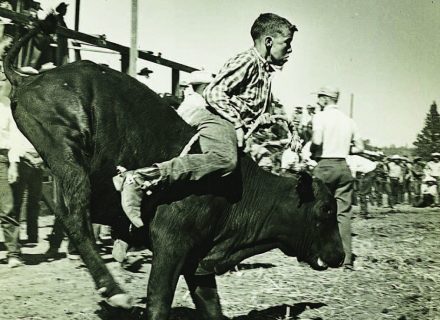Western artist Logan Maxwell Hagege embodies the West from a modernist perspective through his signature bold colors, large shapes, and powerful imagery.
When Stetson decided to honor the 100th anniversary of the painting it has long used in its marketing — Long Megargee's The Last Drop, of a cowboy kneeling to let his horse drink out of his Stetson — the company sought out California-based artist Logan Maxwell Hagege for a still-under-wraps special collaboration. That's just one indication of the cachet, power, and aesthetic appeal of Hagege's work.
At only 42, he's already perched at the top of the Western art market. The in-demand artist's paintings often sell before they leave the easel. He broke the $200,000 price point at auction when he was just 38, but more important than the prices his works command is the impact they have on the definition of what "Western" art is or can be.
Known for his paintings of riders on horseback, Native Americans, cowboys, clouds, cacti, hollyhocks, and rocky desert landscapes, Hagege's bold and bright stylized realism has attracted collectors like musicians Bruno Mars, Brandon Flowers of The Killers, and members of the country band Midland. At the same time, his works are snapped up for the permanent collections of such venerable institutions as the Autry Museum of the American West in Los Angeles, the National Cowboy & Western Heritage Museum in Oklahoma City, and the Booth Western Art Museum in Cartersville, Georgia.
With his paintings, art books, and sold-out serigraph print editions, this Gen Xer is bridging the way for a younger generation of Western artists.
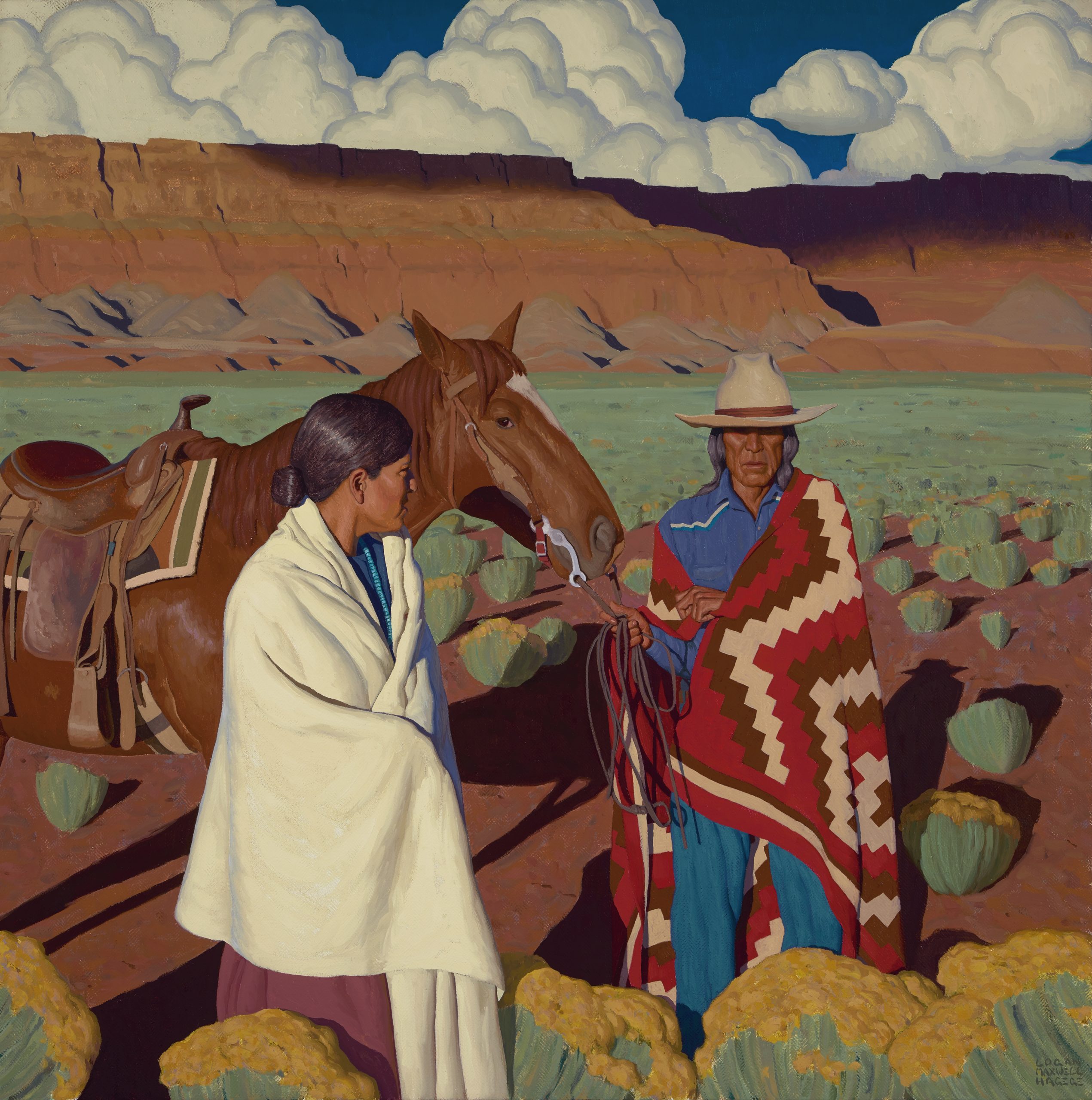 Breathing the Same Air, 40 x 40
Breathing the Same Air, 40 x 40
Hagege has worked in studios ranging from an apartment bedroom to a huge warehouse. His studio now is the ideal one that he built on his five-acre property in one of California's most sought-out small towns, Ojai. Here, the original settlers were Chumash Indians; today, organic agriculture, small businesses, nature, and wellness retreats get top priority, along with the celebrities who live here quietly or come into town on weekend getaways.
About 15 miles inland from Ventura and the Pacific Ocean, the secluded enclave boasts a sunset phenomenon known as the "pink moment" and a Shangri-La-like landscape punctuated with oak, olive, avocado, and orange trees. But it's not mystically beautiful Ojai that Hagege feels drawn to paint; it's the desert Southwest that inspires him. He accomplishes his modernist revisioning of that landscape with large shapes and powerful imagery that exaggerate some aspects (like a horse's musculature or mushrooming clouds) and simplifies others. The exaggerated simplicity can lend an almost otherworldly feeling. Most apparent is his treatment of clouds: They tend to be big, billowing white and cream-colored cumulus clouds, simplified and sometimes rolling through the sky in puffy formation, supplying a sense of movement.
Life began for Hagege (pronounced Ah-jejj) in L.A.'s san Fernando Valley, where he studied at art schools including Associates in Art, and privately under Steve Huston and Joseph Mendez. Family trips to Palm Springs, where his grandmother lived, provided an early familiarity with the desert. Hagege had a self-motivated streak from the get-go, becoming a competitive surfer and starting his own surfboard company at age 16. By his 20s, he was painting stylized artworks with the streamlined shapes that would evolve into his hallmark. By his 30s, Hagege was a sought-after Western artist helping his brother Beau launch L.A.'s Maxwell Alexander Gallery.
A few years ago, Hagege moved an hour or so norht of L.A. to Ojai, population 7,600, where "there's more of a Western culture." On his property there, he has a ranchette, where he, his wife, and their two young children share the land with sheep and chickens. The neighbors have cows and horses. "We always craved the idea of moving out of L.A. and getting into a more rural area that's quieter. Living here has been amazing," he says.
On his Ojai property, he constructed the studio he always wanted. It's 2,000 square feet with 20-foot-high ceilings at the peak, with a large 8-by-8-foot north-facing window and huge rollup doors, so he can take big paintings in and out. He can drive his truck right up to those doors to load or unload his large-scale works. The view from the window is of his chicken coop and some of those amazing Ojai oak trees.
Inside the studio is where you really get to know Hagege. There are easels, paintings in progress, surfboards, Navajo blankets, cowboy hats, Hopi kachinas, and an American flag. It all inspires the modernist take on the West, which emerges more from the impressions he remembers of things he has seen, more so than from his reference photos, although those may contribute to some aspects of his compositions.
We talked about it all — his paintings, his lifestyle, and the next generation of Western art.
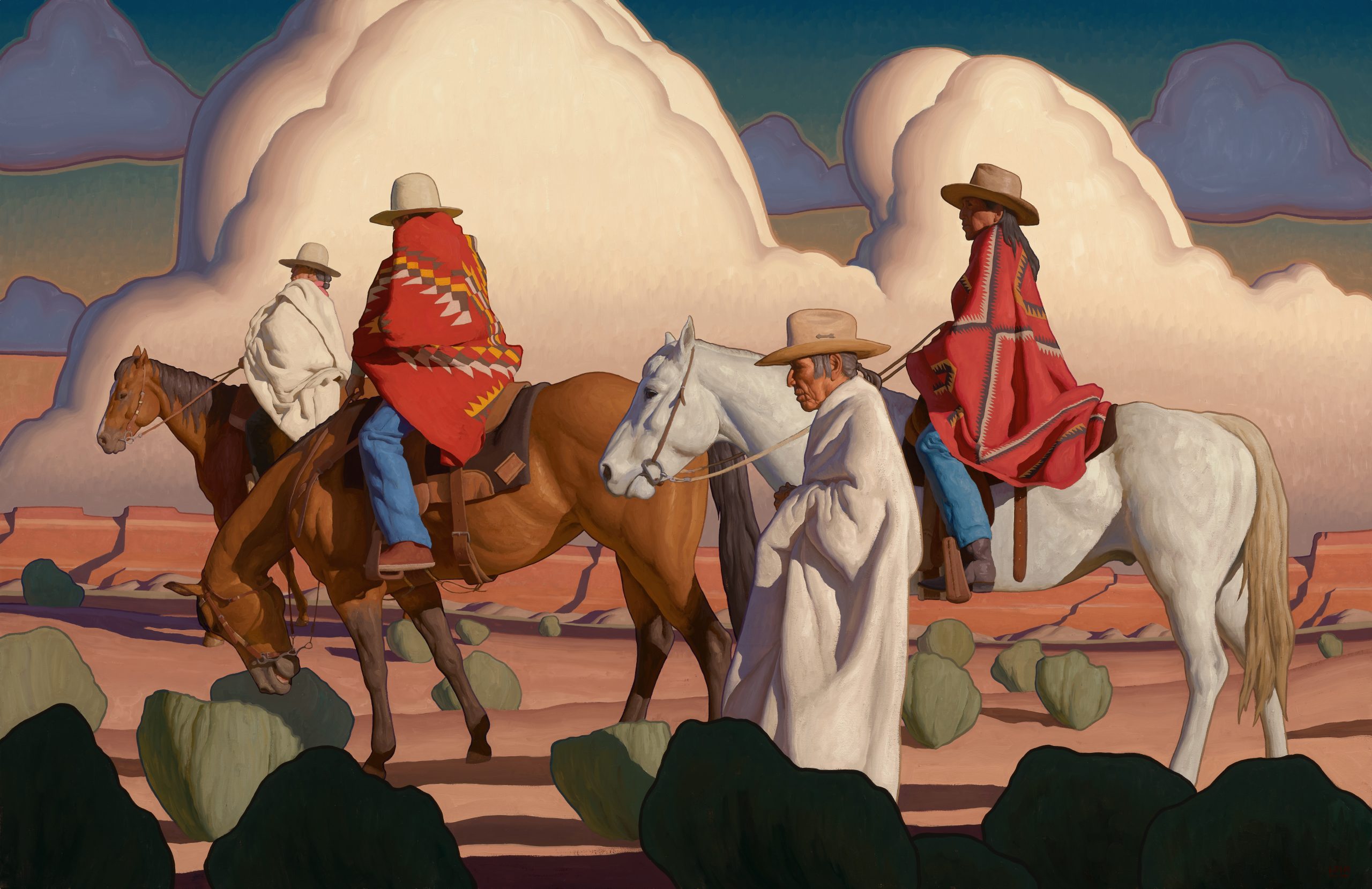 Where the Sagebrush Grows Free, 44 x 68, 2022, oil on canvas
Where the Sagebrush Grows Free, 44 x 68, 2022, oil on canvas
Cowboys & Indians: You mostly paint the Southwest...
Logan Maxwell Hagege: Yeah, pretty exclusively. I try to create my own little visual world. I'm always envious of artists in art history who really make you look at the world differently. Van Gogh's world. Georgia O'Keeffe's world. That's something I really strive for.
C&I: They each had a distinctive style and sense of place. You have ties to Arizona.
Hagege: I have a small house in a remote part of northern Arizona, Marble Canyon, at the base of the Vermilion Cliffs, 45 minutes for Page. It's a very dramatic landscape with towering red cliffs. It's a pretty wild area, about an hour outside of Tuba City. There are a few houses, a couple of motels, and a couple of convenience stores at the gas station, but the closer supermarket is 45 minutes away. No internet, no TV. It's a place to escape and have quiet time and paint on location, as well as take photos. I kind of use it like a clubhouse for other artists. We'll meet there and spend time painting on location, sharing stories and ideas.
C&I: Sounds like a setting Maynard Dixon would have appreciated. How do Dixon, Gustav Klimt, and N.C. Wyeth — all very different painters — inspire you?
Hagege: Klimt — his designs, his shapes were so specific and interesting. Wyeth — I love his creativity; he used photo references but made up a lot of aspects in his compositions. Dixon — it feels like he had a soulful connection to the desert in his work. Things are simplified and make a strong statement with relatively little information in the paintings.
C&I: At the same time, you seem like you're partial to the Gene Autry-Dale Evans era.
Hagege: I am! About 12 or 15 years ago I was in Santa Fe staying at Billy Schenck's guesthouse, and the closet was filled with those old cowboy movies. Every night I stayed there I watched a different western movie of that era.
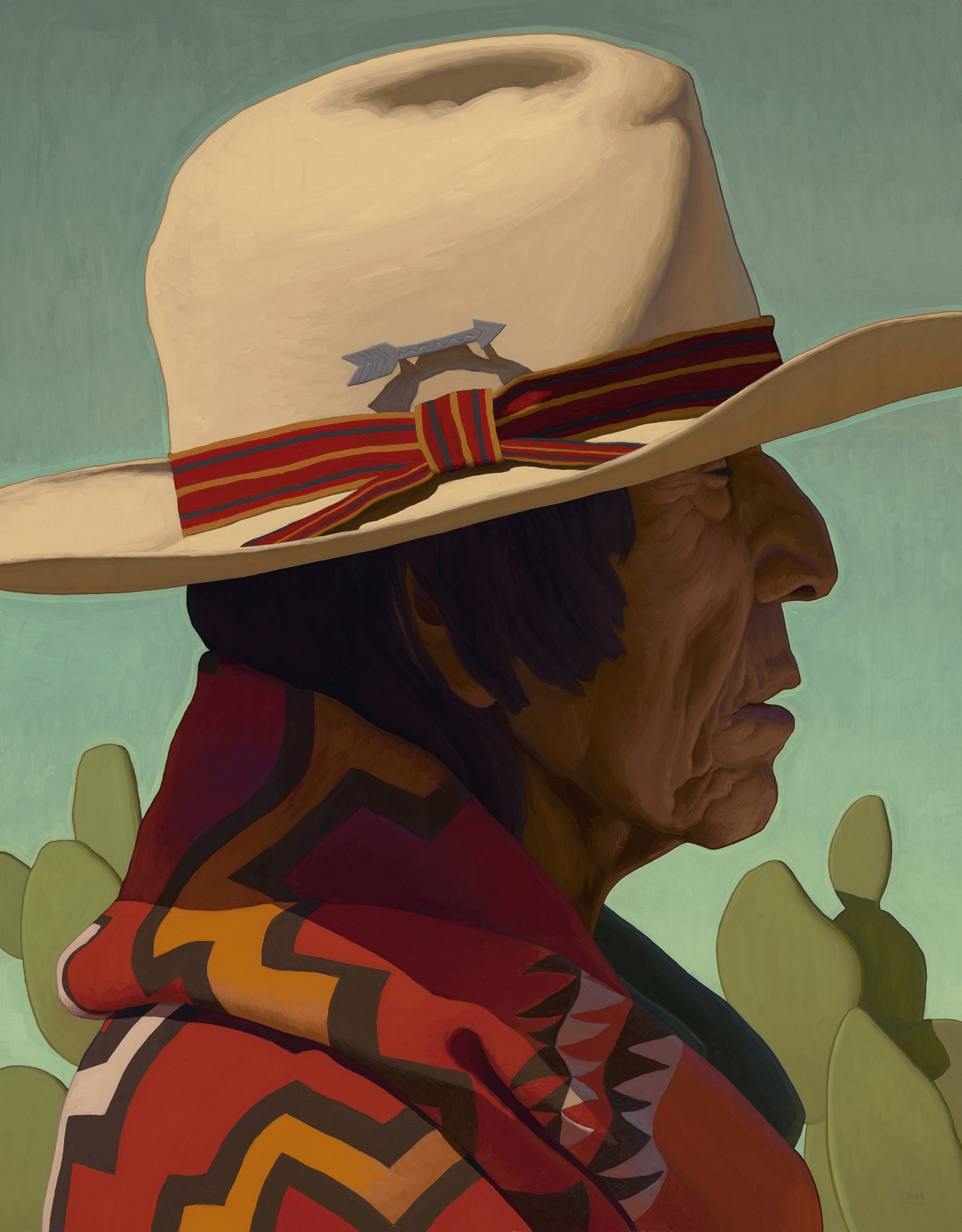 The Man From Bylas, 2020
The Man From Bylas, 2020
C&I: You and Schenck have a particular affinity for clouds. Your signature clouds are a big part of the painted world you create.
Hagege: A lot of times I'm thinking of big shapes in the desert. All the clouds I paint and a lot of the other shapes and elements are distant memories for me, burnt into my brain. My brain remembers these fuzzy details, which make their way into my paintings as strong, simplified visions. So they represent a memory, a feeling. Instead of being handcuffed to a photo reference, I prefer to refer to photos when needed but rely on my memory and feeling in a big way. Usually there's a good amount of editing to make an image work. I have to edit things down to support my composition. Some of this I learned painting outdoors because the light changes so fast on location that I am forced to simplify details to get a painting completed.
C&I: People identify you and your work with the desert, but you're a surfer. How do surfing and your art relate?
Hagege: The independent aspect of it is the clear link. When you're surfing, you're out there doing your own thing. The best part of surfing is being free and doing whatever you feel like doing. In art as well. The idea of creating something that interests me represents a similar type of freedom with my art. I don't think about the end goal of selling the painting because it'll tighten me up and it'll restrict my vision or what I might do. By taking this pressure off of myself, I am able to create more freely, without worrying about who will see it or whether or not it will be salable.
C&I: Surfers like to go big, and your paintings are sometimes oversize, like 8 feet by 12 feet. I guess you need a ladder for those.
Hagege: Yeah, definitely. I have an 8-foot rolling ladder in the studio to help reach the tops of the larger canvases. The paintings start with the idea drawing. Then color studies as a roadmap. Then I'll start the canvas and work on it for a month or more. Larger paintings will take me much longer. I might work on one for around a year. I'll usually work on a large piece here and there for a long period of time, making sure not to rush it. It'll be in the background of my studio. Lots of paints!
I don't think about the end goal of selling the painting because it'll tighten me up and it'll restrict my vision or what I might do. By taking this pressure off of myself, I am able to create more freely, without worrying about who will see it or whether or not it will be salable.
C&I: You mostly paint in series. What are you working on now?
Hagege: I paint 12 to 15 paintings a year. Half of them go to the museum shows. The paintings are usually 30 by 30 or larger. I plan a show two years out. Right now I'm working on portraits of American Indians and landscapes that I am making up out of my head.
C&I: Are the Indians you paint usually from the Hopi and Navajo Nations?
Hagege: I've painted people from Taos Pueblo, Navajo, Apache. I'd love to spend more time on the Hopi mesa. My visits there have always been inspiring. The culture and local artists are both so special.
C&I: I love your hollyhock series, particularly Running Wild, your 2021 painting of a cowboy on a bucking bronco with giant red hollyhocks in front of him and a single white cloud billowing behind him. I bet that sold right away.
Hagege: It did. It never actually made it to a gallery wall. I have some great collectors in Arizona that Maxwell Alexander Gallery sold it to. Compositionally, I was thinking about the horizontal movement of the horse and rider, and the vertical stems of the hollyhocks. I liked the feel of these opposing forces. I really liked the masculine, hard, rough feel of the cowboy on the horse against the more gentle, feminine feeling of the hollyhocks. Hollyhocks have become a more recent inspiration for me. I see them pop up everywhere here in Ojai in the late spring/early summer. They're also in Santa Fe and Taos, and they're big, bold shapes, which I am clearly fond of.
C&I: How would you sum up your aesthetic of the West?
Hagege: I'm attracted to big, simple shapes, which is why I gravitate to the desert. There's the sky, the clouds, some sort of mountain or mesa or cliff element in the background, a clear middle ground, and a foreground. Mentally I can break it down into four or five big shapes. I really love late-daylight, when there is that warm, glowing, strong light and shadow. I build my paintings around the light and shadow and the big shapes.
C&I: Your work broke new ground for Western art. What's the next generation bringing to it?
Hagege: More of a modernistic look at the West. Art in the West is more than one thing. And I believe there is room for many takes on the West. Art has always fascinated me for this reason. Five different artists can look at a subject and you'll get five completely different compositions. Besides a new viewpoint, I think the most important thing that the new generation of artists is bringing to Western art is a new audience. Young people have gained a new appreciation for the West and the art that is being created here. I am glad to see this newer generation of art lovers showing interest in this amazing part of America that I am so fortunate to be inspired by on a daily basis.
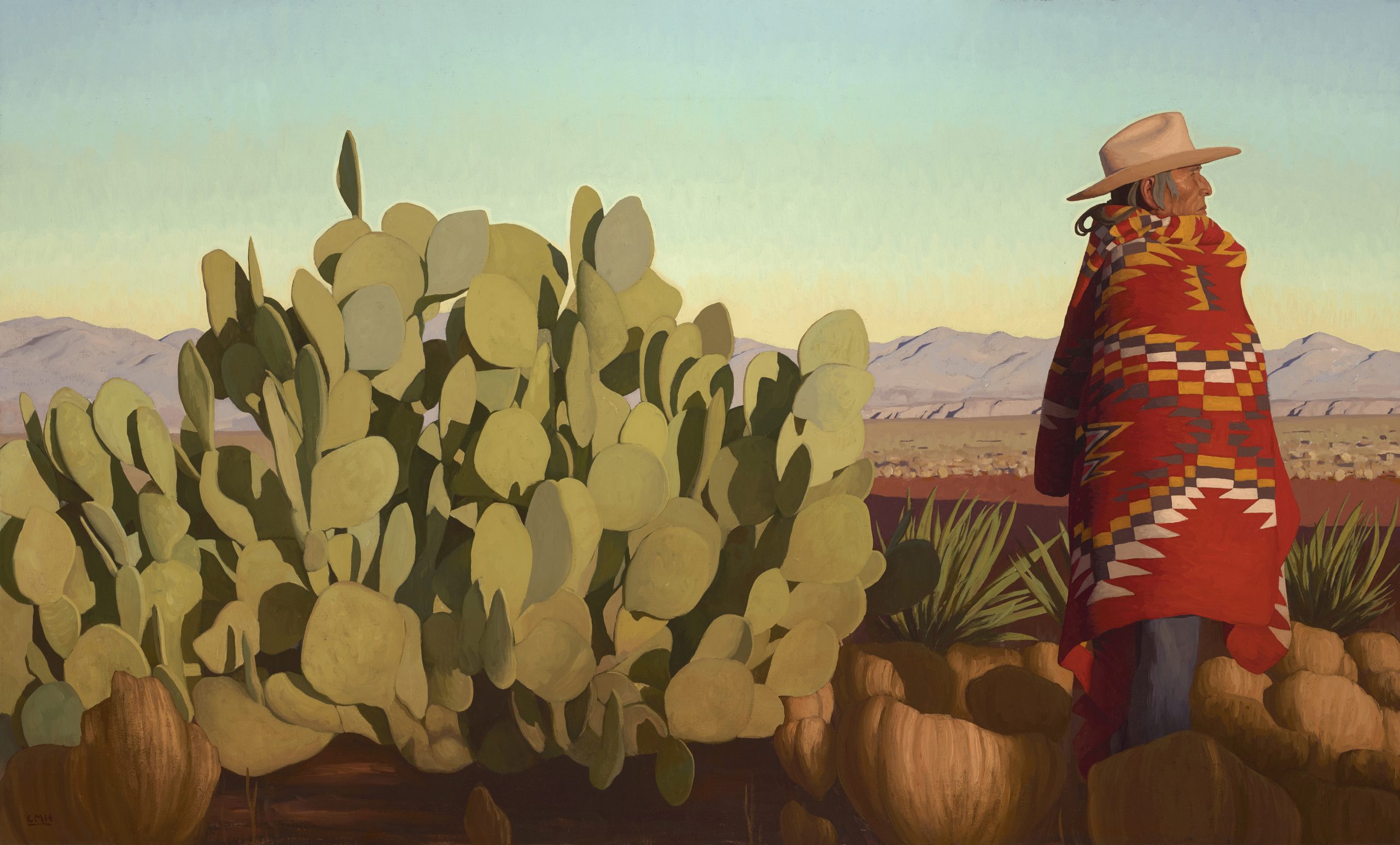 Arizonaland, 30 x 50
Arizonaland, 30 x 50
Logan Maxwell Hagege is represented by Maxwell Alexander Gallery in Los Angeles; Gerald Peters Gallery in Santa Fe and New York; and Medicine Man Gallery in Tuscon, Arizona. He will be part of Maxwell Alexander Gallery's 10th anniversary group show on view through November; he'll also have a solo show at the gallery in fall of 2023. Hagege is the subject of a documentary film, Desert Survey, due out in late 2022. A signed, limited artist edition of his Pendleton blanket, Resting Place, is being released in December through the Maxwell Alexander Gallery. Find out more about the artist at maxwellalexandergallery.com and loganmaxwellhagege.com.














